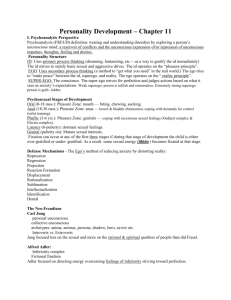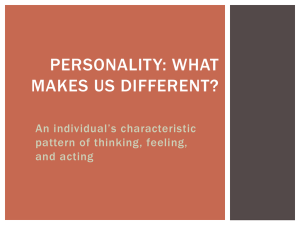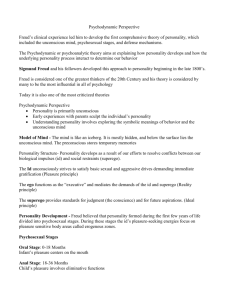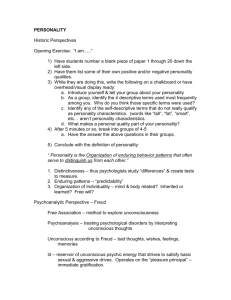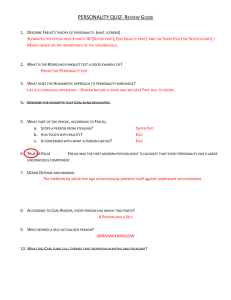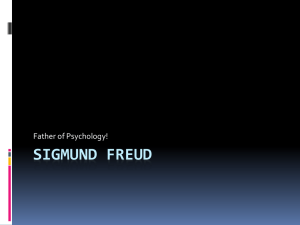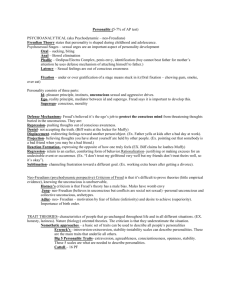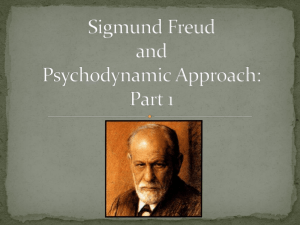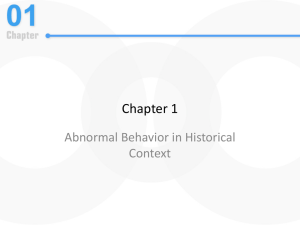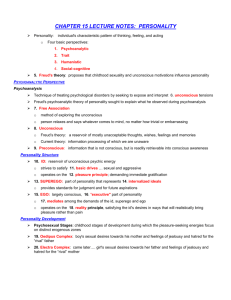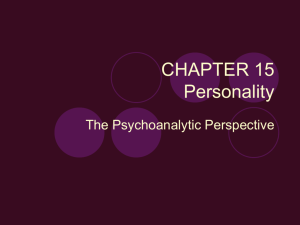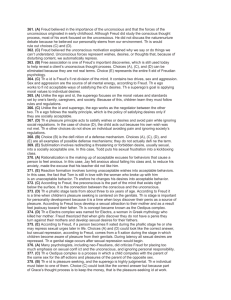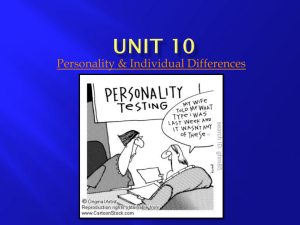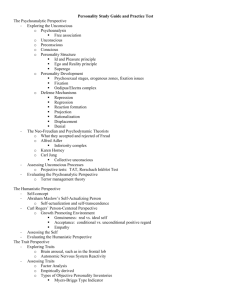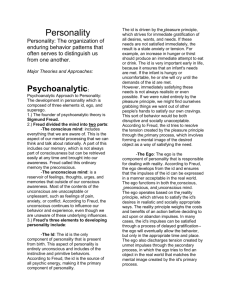Personality
advertisement
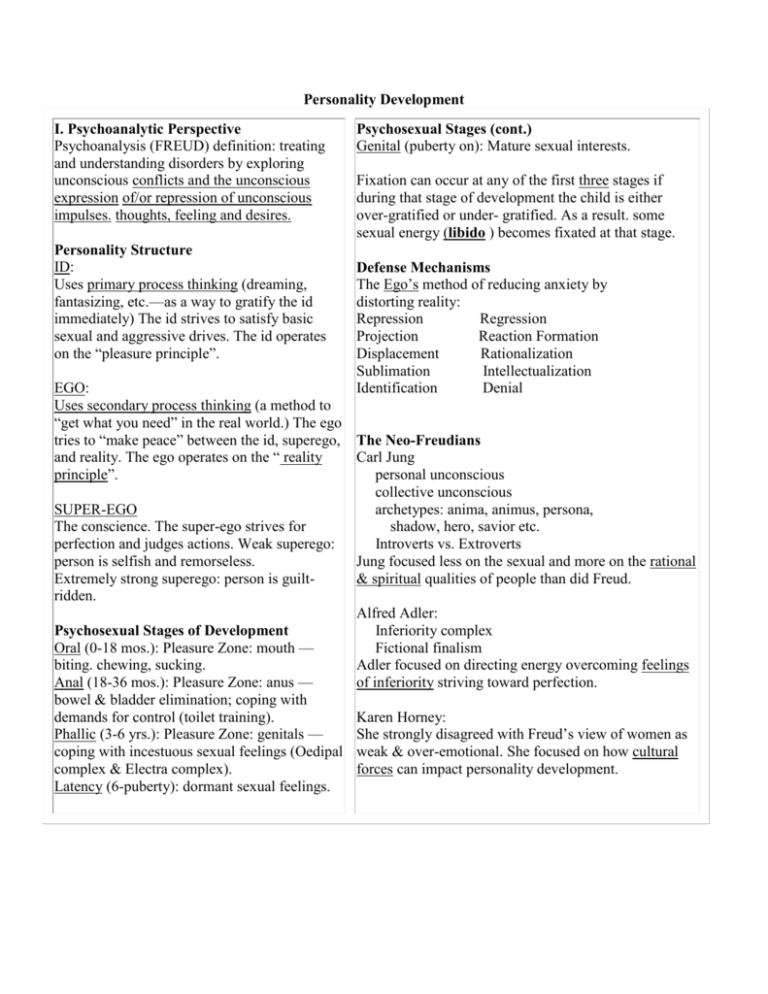
Personality Development I. Psychoanalytic Perspective Psychoanalysis (FREUD) definition: treating and understanding disorders by exploring unconscious conflicts and the unconscious expression of/or repression of unconscious impulses. thoughts, feeling and desires. Personality Structure ID: Uses primary process thinking (dreaming, fantasizing, etc.—as a way to gratify the id immediately) The id strives to satisfy basic sexual and aggressive drives. The id operates on the “pleasure principle”. Psychosexual Stages (cont.) Genital (puberty on): Mature sexual interests. Fixation can occur at any of the first three stages if during that stage of development the child is either over-gratified or under- gratified. As a result. some sexual energy (libido ) becomes fixated at that stage. Defense Mechanisms The Ego’s method of reducing anxiety by distorting reality: Repression Regression Projection Reaction Formation Displacement Rationalization Sublimation Intellectualization Identification Denial EGO: Uses secondary process thinking (a method to “get what you need” in the real world.) The ego tries to “make peace” between the id, superego, The Neo-Freudians and reality. The ego operates on the “ reality Carl Jung principle”. personal unconscious collective unconscious SUPER-EGO archetypes: anima, animus, persona, The conscience. The super-ego strives for shadow, hero, savior etc. perfection and judges actions. Weak superego: Introverts vs. Extroverts person is selfish and remorseless. Jung focused less on the sexual and more on the rational Extremely strong superego: person is guilt& spiritual qualities of people than did Freud. ridden. Alfred Adler: Inferiority complex Psychosexual Stages of Development Oral (0-18 mos.): Pleasure Zone: mouth — Fictional finalism biting. chewing, sucking. Adler focused on directing energy overcoming feelings Anal (18-36 mos.): Pleasure Zone: anus — of inferiority striving toward perfection. bowel & bladder elimination; coping with demands for control (toilet training). Karen Horney: Phallic (3-6 yrs.): Pleasure Zone: genitals — She strongly disagreed with Freud’s view of women as coping with incestuous sexual feelings (Oedipal weak & over-emotional. She focused on how cultural complex & Electra complex). forces can impact personality development. Latency (6-puberty): dormant sexual feelings. Neo-Freudians (cont.) Erik Erikson: 8 stages of Psychosocial Development: Erikson stressed the importance of the quality of parent-child relationships in personality development. He did, however agree with most of what Freud said about sexual instincts and the libido. II. Humanistic Perspective These theories stress the fundamental goodness of people and their striving toward higher levels of functioning. Carl Rogers: actualizing tendency fully-functioning person unconditional positive regard vs. conditional positive regard person-centered therapy Abraham Maslow: self-actualization hierarchy of motives III. Behavioral Perspective: B.F. Skinner: The environment shapes behavior through reinforcement contingencies. Antecedents→Behaviors→Consequences The theory denies any impact from cognition. unconscious desires or personal striving. (See unit on Learning Theory) IV. Social-Cognitive Perspectives: Based on Skinner’s learning theory but also incorporates cognition, and social influences. Bandura: (Social Learning Theory): Reciprocal Determinism: ↔behavior↔personal/cognitive factors↔environment↔ Observation Learning (modeling) Social-Cognitive (cont.) Rotter: Locus of Control: Internal vs. External Seligman: Learned Helplessness: uncontrollable bad events→ perceived lack of control→ generalized helpless behavior (depression) V. The Trait Perspective Theorists are interested in DESCRIBING personality not EXPLAINING it. Sheldon: (Body types): endomorphs, mesomorphs & ectomorphs. Cattell: By using factor analysis, determined their were 16 basic personality traits. (developed the 16PF) Eysenk: 2 personality dimensions: stable vs unstable & introverted vs extroverted BIG 5 Personality Factors: stability, extraversion, openness, aggreeableness, & conscientiousness. **REMEMBER: Most psychologists today are Eclectic. They don’t adhere to just one personality theory. Instead, they draw from several theories. Personality Assessment The Personal Interview Observation Objective Tests: used to assess personality traits. 16PF (Cattell)-assesses "normal” traits MMPI : intended for psychiatric diagnoses or “abnormal” traits. Projective Tests: used to assess unconscious motives & conflicts. Rorschach : consists of ambiguous inkblots. The way a person interprets them reveals aspects of the personality TAT: (Thematic Apperception Test): consists of ambiguous pictures about which a person tells a story. The stories provide clues as to internal motives, needs, and drives.
